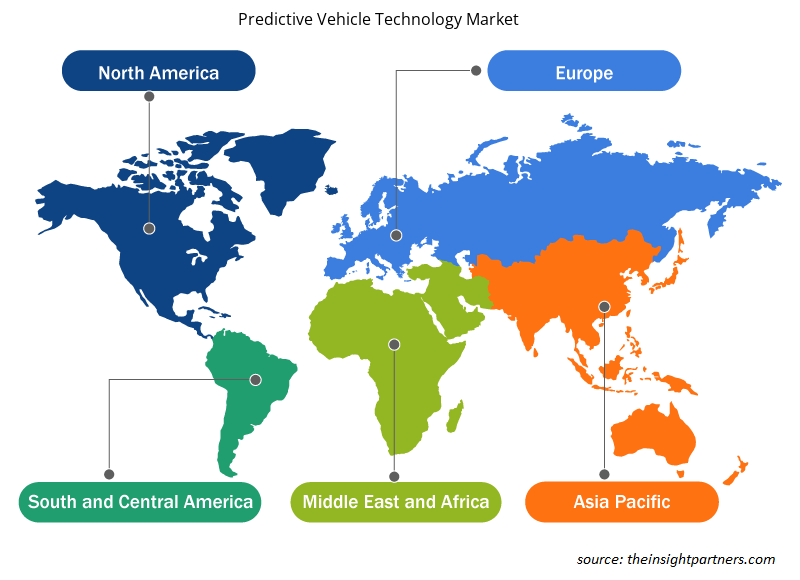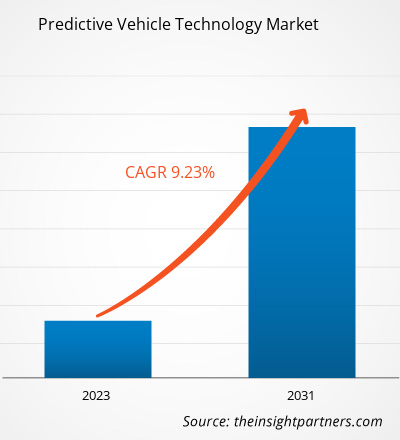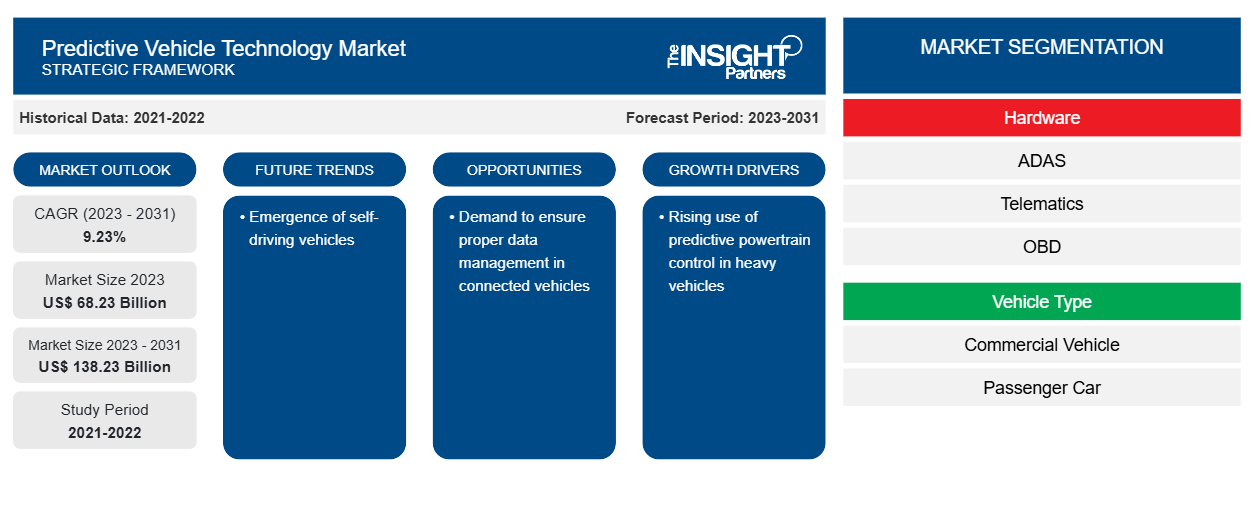予測車両技術の市場規模は、2023年の682.3億米ドルから2031年には1382.3億米ドルに達すると予測されています。市場は2023年から2031年にかけて9.23%のCAGRを記録すると予想されています。PPCの利点により、自動車メーカー、特に大型商用車メーカーは自社の車両にPPCを統合しています。PPCは、ほぼすべてのタイプのトラックと大型車両に後付けできます。
予測車両技術市場分析
世界の予測車両技術市場のエコシステムの主な利害関係者には、技術プロバイダー、コンポーネントプロバイダー、OEM、自動車業界のエンドユーザーセグメントが含まれます。技術プロバイダーは、自動車メーカーにAI、ML、予測技術を提供し、この技術をADAS、OBD、テレマティクス、V2Xなどのシステムに統合します。このシステムのコンポーネントメーカーには、センサー、カメラ、ディスプレイなどが含まれます。その後、技術が統合されたシステム製品が車両に取り付けられ、ドライバーと乗客の両方の安全とセキュリティを確保することで、ユーザーに手間のかからないエクスペリエンスを提供します。OEMで構成される流通チャネルは、完成した最終製品をエンドユーザーのカテゴリに提供します。乗用車と商用車の両方が、予測技術と統合された完成品を車両に使用しています。予測自動車技術は、車、バン、SUV、トラックなど、あらゆる種類の車両に応用されています。
予測車両技術市場の概要
現在、自動車業界では、乗員の安全性と効率性を向上させるために、さまざまな先進技術が車に大幅に取り入れられています。自動車メーカーは、人工知能 (AI) と機械学習 (ML) を活用して、ドライバーのパターンと傾向を認識し、車両の安全性を向上させています。両方の技術は、今後の車両と自動車業界の重要な部分になる準備ができています。コネクテッドカーと自動運転車の競争では、予測車両技術がすべてのタイプの自動車に受け入れられつつあり、ドライバーと乗客に顕著な利便性を提供します。そのため、自動車メーカーは、音声コマンドをサポートする車両にコネクテッドガジェットと IoT を採用することに注力しています。コネクテッドカーへの IoT の統合は、自動車業界で続く次の大きなデジタル開発です。この事実は、自動運転車の導入を通じて別の革命をもたらすことになります。自動運転車/自律走行車には、IoT 車両間通信を可能にし、現実のものにするセンサー管理システムが含まれています。前述のコネクテッドカーの要素は、予測衝突回避システム、予測メンテナンスシステムなどの導入により、予測技術の活用に貢献すると予測されています。
要件に合わせてレポートをカスタマイズする
このレポートの一部、国レベルの分析、Excelデータパックなど、あらゆるレポートを無料でカスタマイズできます。また、スタートアップや大学向けのお得なオファーや割引もご利用いただけます。
-
このレポートの主要な市場動向を入手してください。この無料サンプルには、市場動向から見積もりや予測に至るまでのデータ分析が含まれます。
予測車両技術市場の推進要因と機会
大型車両における予測パワートレイン制御の利用増加
予測パワートレイン制御 (PPC) は数年前に登場し、現在勢いを増しています。PPC の採用により、長距離交通での燃料消費を最大 5% 削減できます。これは、インテリジェントな予測を通じて金銭的リソースを節約する独自のクルーズ コントロール システムです。PPC は、3D マップと GPS データを使用して前方の道路をスキャンします。その後、システムはそれに応じて走行しながら速度を自動的に調整します。PPC のレトロフィットの改善は、すでにトラックで使用されている FleetBoard テレマティクス サービスと非常によく適合します。大型トラック メーカーは、補完的なビジネス ユニットにアプローチして、製品ポートフォリオを改善し、PPC のトレンドに関する専門知識をさらに獲得しています。たとえば、メルセデス ベンツの PPC テクノロジは、ヨーロッパ全土のメルセデス ベンツ パートナーによって Actros、Arcos、および Antos にレトロフィットできます。メルセデス ベンツの PPC は、長距離走行の大型車両の平均 64% を注文しています。大型商用車の需要の高まりにより、大型車両での予測テクノロジの採用が拡大すると予測されています。
コネクテッドカー分野での追求における一般的な機会はデータ管理です。コネクテッドカーは膨大な量のデータをクラウドにストリーミングしているため、膨大なデータを活用するために、予測分析とデータ分析の必要性が高まっています。予測衝突回避、予測メンテナンス、自動車マーケティング、自動車マーケティング、コネクテッドビークルのデータ管理は、市場の成長を担う成長中のコンセプトの一部です。もう1つの特徴は、車両における予測技術の使用を促進することです。日産は、ビッグデータ、高度なセンサー、車両間接続の助けを借りて、予測衝突回避システムを開発しました。このシステムにより、車の前の車両と前の2台の車両との距離と速度を判断できます。また、異常な動作があった場合は、ビデオと音声信号がドライバーに送信されます。したがって、予測衝突回避システムの大きな利点により、開発者がコネクテッドビークル間の通信を改善するためのアプリの作成に取り組んでいるため、自動車業界では予測ドライバーの動作に基づく高度で効果的な衝突回避システムを目撃する可能性があります。
予測車両技術市場レポートのセグメンテーション分析
予測的な車両技術市場分析の導出に貢献した主要なセグメントは、ハードウェア、車両タイプ、およびアプリケーションです。
- ハードウェアに基づいて、市場はADAS、テレマティクス、OBDに分割されています。ゴルフカートセグメントは2023年に大きな市場シェアを占めました。
- 予測車両技術市場は、車種別に商用車、乗用車に分類されます。2023年には乗用車セグメントが最大の市場シェアを占めました。
- アプリケーションに基づいて、予測車両技術市場は、予防警告、安全性、セキュリティに分類されます。安全性とセキュリティのセグメントは、2023年に市場で最大のシェアを占めました。
地域別の予測車両技術市場分析
予測車両技術市場レポートの地理的範囲は、主に北米、ヨーロッパ、アジア太平洋、中東およびアフリカ、南米の 5 つの地域に分かれています。
米国、カナダ、メキシコは北米の主要経済国です。北米地域は、高い技術進歩により、人口増加と高い購買力によるさまざまな技術開発が引き寄せられ、競争の激しい市場であり続けています。長年にわたり、車両は車輪の付いたコンピューターのようになってきており、現代の工場技術者は専門的な予測分析ツールがなければ仕事をすることができません。予測メンテナンスにより、自動車メーカーは自動車部品が壊れる前に修理することができます。予測メンテナンスを使用することで、メーカーは製造プロセスを変更し、将来の製品の問題を解消することができます。この地域は技術の面で非常に進んでいるため、さまざまな企業が乗用車や商用車に予測メンテナンスツールを統合しています。
予測車両技術市場の地域別洞察
予測期間を通じて予測車両技術市場に影響を与える地域的な傾向と要因は、Insight Partners のアナリストによって徹底的に説明されています。このセクションでは、北米、ヨーロッパ、アジア太平洋、中東およびアフリカ、南米および中米にわたる予測車両技術市場のセグメントと地理についても説明します。

- 予測車両技術市場の地域別データを入手
予測車両技術市場レポートの範囲
| レポート属性 | 詳細 |
|---|---|
| 2023年の市場規模 | 682.3億米ドル |
| 2031年までの市場規模 | 1,382.3億米ドル |
| 世界のCAGR(2023年~2031年) | 9.23% |
| 履歴データ | 2021-2022 |
| 予測期間 | 2023-2031 |
| 対象セグメント |
ハードウェア別
|
| 対象地域と国 |
北米
|
| 市場リーダーと主要企業プロフィール |
|
予測車両技術市場のプレーヤー密度:ビジネスダイナミクスへの影響を理解する
予測車両技術市場は、消費者の嗜好の変化、技術の進歩、製品の利点に対する認識の高まりなどの要因により、エンドユーザーの需要が高まり、急速に成長しています。需要が高まるにつれて、企業は提供を拡大し、消費者のニーズを満たすために革新し、新たなトレンドを活用し、市場の成長をさらに促進しています。
市場プレーヤー密度とは、特定の市場または業界内で活動している企業または会社の分布を指します。これは、特定の市場スペースに、その規模または総市場価値と比較して、どれだけの競合相手 (市場プレーヤー) が存在するかを示します。
予測車両技術市場で事業を展開している主要企業は次のとおりです。
- アイシン精機株式会社
- 株式会社
- アプティブPLC
- トラフィログ株式会社
- コンチネンタルAG
免責事項:上記の企業は、特定の順序でランク付けされていません。

- 予測車両技術市場のトップキープレーヤーの概要を入手
予測車両技術市場のニュースと最近の動向
予測車両技術市場は、主要な企業出版物、協会データ、データベースを含む一次および二次調査後の定性的および定量的データを収集することによって評価されます。以下は、予測車両技術市場と戦略の市場動向のリストです。
- ニューオーリンズ市は2023年11月、コネクテッド・オペレーションズ・クラウドのパイオニアであるサムサラ社の技術を活用し、ニューオーリンズ警察署(NOPD)、ニューオーリンズ消防署(NOFD)、公共事業局(DPW)、法執行部、公園・公園道路局(PPW)、衛生局など41の部署にわたる市の車両運用の安全性、効率性、持続可能性を向上させると発表しました。市は車両に7,500万ドルを投資しており、サムサラ社との技術提携は車両の維持と保護に不可欠であると考えています。(出典:サマラ社、プレスリリース/企業ウェブサイト/ニュースレター)
- 2023年9月、主要インフラサービスプロバイダーであるMグループサービスのフリート管理運営事業であるMグループサービスプラント&フリートソリューション(MGSPFS)は、Connected Operations™クラウドの先駆者であるSamsara、英国を拠点とするフリート安全ソリューションプロバイダーであるMotormaxと協力し、ドライバー、道路利用者、市民を保護するための次世代の車載安全システムを提供しています。(出典:Mグループサービスプラント&フリートソリューション、プレスリリース/会社ウェブサイト/ニュースレター)
対象範囲と成果物
「予測車両技術市場の規模と予測(2021〜2031年)」レポートでは、以下の分野をカバーする市場の詳細な分析を提供しています。
- 対象範囲に含まれるすべての主要市場セグメントの世界、地域、国レベルでの市場規模と予測
- 市場の動向(推進要因、制約、主要な機会など)
- 今後の主な動向
- ポーターのファイブフォース分析の詳細
- 主要な市場動向、主要プレーヤー、規制、最近の市場動向を網羅した世界および地域の市場分析
- 市場集中、ヒートマップ分析、主要プレーヤー、最近の動向を網羅した業界の状況と競争分析
- SWOT分析による詳細な企業プロフィール
- 過去2年間の分析、基準年、CAGRによる予測(7年間)
- PEST分析とSWOT分析
- 市場規模価値/数量 - 世界、地域、国
- 業界と競争環境
- Excel データセット
最新レポート
関連レポート
お客様の声
購入理由
- 情報に基づいた意思決定
- 市場動向の理解
- 競合分析
- 顧客インサイト
- 市場予測
- リスク軽減
- 戦略計画
- 投資の正当性
- 新興市場の特定
- マーケティング戦略の強化
- 業務効率の向上
- 規制動向への対応























 無料サンプルを入手 - 予測車両技術市場
無料サンプルを入手 - 予測車両技術市場